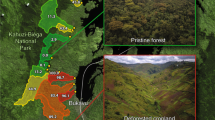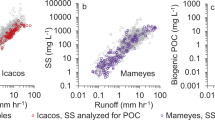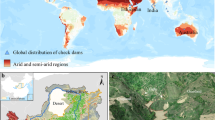Abstract
Approximately 8% of anthropogenic carbon dioxide emissions are estimated to come from land-use change1, but this estimate excludes fluxes of terrestrial carbon to aquatic ecosystems from human disturbance. Carbon fluxes from land to rivers have probably increased by 0.1 to 0.2 petagrams of carbon per year as a result of disturbances such as deforestation, agricultural intensification and the injection of human wastewater2. Most dissolved organic carbon in rivers originates from young organic carbon from soils and vegetation3, but aged carbon removed from the modern carbon cycle is also exported in many systems. Here we analyse a global data set of radiocarbon ages of riverine dissolved organic carbon and spatial data on land cover, population and environmental variables. We find that the age of dissolved organic carbon in rivers increases with population density and the proportion of human-dominated landscapes within a watershed, and decreases with annual precipitation. We reason that disturbance reintroduces aged soil organic matter into the modern carbon cycle, although fossil carbon in fertilizer or petroleum products may also be a source of aged carbon in disturbed watersheds. The total export from the terrestrial environment to freshwater systems remains unknown; nevertheless, our results suggest that 3–9% of dissolved organic carbon in rivers is aged carbon mobilized by human disturbance.
This is a preview of subscription content, access via your institution
Access options
Subscribe to this journal
Receive 12 print issues and online access
$259.00 per year
only $21.58 per issue
Buy this article
- Purchase on Springer Link
- Instant access to full article PDF
Prices may be subject to local taxes which are calculated during checkout



Similar content being viewed by others
References
Le Quéré, C. et al. Global carbon budget 2013. Earth Syst. Sci. Data Discuss. 6, 689–760 (2013).
Regnier, P. et al. Anthropogenic perturbation of the carbon fluxes from land to ocean. Nature Geosci. 6, 597–607 (2013).
Findlay, S. & Sinsabaugh, R. L. Aquatic Ecosystems: Interactivity of Dissolved Organic Matter (Academic, 2003).
Butman, D., Raymond, P. A., Butler, K. & Aiken, G. Relationships between Δ14C and the molecular quality of dissolved organic carbon in rivers draining to the coast from the conterminous United States. Glob. Biogeochem. Cycles 26, GB4014 (2012).
Moore, S. et al. Deep instability of deforested tropical peatlands revealed by fluvial organic carbon fluxes. Nature 493, 660–663 (2013).
Sickman, J. O., DiGiorgio, C. L., Davisson, M. L., Lucero, D. M. & Bergamaschi, B. Identifying sources of dissolved organic carbon in agriculturally dominated rivers using radiocarbon age dating: Sacramento-San Joaquin River Basin, California. Biogeochemistry 99, 79–96 (2010).
Raymond, P. A. et al. Controls on the variability of organic matter and dissolved inorganic carbon ages in northeast US rivers. Mar. Chem. 92, 353–366 (2004).
Moyer, R., Bauer, J. & Grottoli, A. Carbon isotope biogeochemistry of tropical small mountainous river, estuarine, and coastal systems of Puerto Rico. Biogeochemistry 112, 589–612 (2013).
Caraco, N., Bauer, J. E., Cole, J. J., Petsch, S. & Raymond, P. Millennial-aged organic carbon subsidies to a modern river food web. Ecology 91, 2385–2393 (2010).
Griffith, D. R., Barnes, R. T. & Raymond, P. A. Inputs of fossil carbon from wastewater treatment plants to US rivers and oceans. Environ. Sci. Technol. 43, 5647–5651 (2009).
Bianchi, T. S. et al. Enhanced transfer of terrestrially derived carbon to the atmosphere in a flooding event. Geophys. Res. Lett. 40, 116–122 (2013).
McCallister, S. L. & del Giorgio, P. A. Evidence for the respiration of ancient terrestrial organic C in northern temperate lakes and streams. Proc. Natl Acad. Sci. USA 109, 16963–16968 (2012).
Raymond, P. A. et al. Global carbon dioxide emissions from inland waters. Nature 503, 355–359 (2013).
Fellman, J. B. et al. Dissolved organic carbon biolability decreases along with its modernization in fluvial networks in an ancient landscape. Ecology 95, 2622–2632 (2014).
Evans, C. D. et al. Evidence against recent climate-induced destabilisation of soil carbon from C-14 analysis of riverine dissolved organic matter. Geophys. Res. Lett. 34, L07407 (2007).
Petrone, K. C., Fellman, J. B., Hood, E., Donn, M. J. & Grierson, P. F. The origin and function of dissolved organic matter in agro-urban coastal streams. J. Geophys. Res. 116, G01028 (2011).
Stubbins, A. et al. Anthropogenic aerosols as a source of ancient dissolved organic matter in glaciers. Nature Geosci. 5, 198–201 (2012).
Abril, G. et al. Amazon River carbon dioxide outgassing fuelled by wetlands. Nature 505, 395–398 (2014).
Battin, T. J. et al. Biophysical controls on organic carbon fluxes in fluvial networks. Nature Geosci. 1, 95–100 (2008).
Dubois, K. D., Lee, D. & Veizer, J. Isotopic constraints on alkalinity, dissolved organic carbon, and atmospheric carbon dioxide fluxes in the Mississippi River. J. Geophys. Res. 115, G02018 (2010).
Moore, J. W. & Semmens, B. X. Incorporating uncertainty and prior information into stable isotope mixing models. Ecol. Lett. 11, 470–480 (2008).
Schneider, A., Friedl, M. A. & Potere, D. A new map of global urban extent from MODIS satellite data. Environ. Res. Lett. 4, 044003 (2009).
Foley, J. A. et al. Global consequences of land use. Science 309, 570–574 (2005).
Ramankutty, N. & Foley, J. Estimating historical changes in global land cover: Croplands from 1700 to 1992. Glob. Biogeochem. Cycles 13, 997–1027 (1999).
Lauerwald, R., Hartmann, J., Ludwig, W. & Moosdorf, N. Assessing the nonconservative fluvial fluxes of dissolved organic carbon in North America. J. Geophys. Res. 117, G01027 (2012).
Wilson, H. F. & Xenopoulos, M. A. Effects of agricultural land use on the composition of fluvial dissolved organic matter. Nature Geosci. 2, 37–41 (2009).
Kaiser, K. & Kalbitz, K. Cycling downwards—dissolved organic matter in soils. Soil Biol. Biochem. 52, 29–32 (2012).
Mackey, B. et al. Untangling the confusion around land carbon science and climate change mitigation policy. Nature Clim. Change 3, 552–557 (2013).
Post, W. M. & Kwon, K. C. Soil carbon sequestration and land-use change: Processes and potential. Glob. Change Biol. 6, 317–327 (2000).
Barnes, R. T. Determining the Relative Importance of Fluxes and Processes to Nitrogen and Carbon Export from Temperate Watersheds Forestry and Environmental Studies PhD thesis, New Haven Yale University 193 (2009)
Billett, M. F., Garnett, M. H. & Harvey, F. UK peatland streams release old carbon dioxide to the atmosphere and young dissolved organic carbon to rivers. Geophys. Res. Lett. 34, L23401 (2007).
Longworth, B. E., Petsch, S. T., Raymond, P. A. & Bauer, J. E. Linking lithology and land use to sources of dissolved and particulate organic matter in headwaters of a temperate, passive-margin river system. Geochim. Cosmochim. Acta 71, 4233–4250 (2007).
Lu, Y. et al. Photochemical and microbial alteration of dissolved organic matter in temperate headwater streams associated with different land use. J. Geophys. Res. 118, 566–580 (2013).
Moyer, R., Bauer, J. & Grottoli, A. Carbon isotope biogeochemistry of tropical small mountainous river, estuarine, and coastal systems of Puerto Rico. Biogeochemistry 112, 589–612 (2013).
Nara, F. W. et al. Radiocarbon measurements of dissolved organic carbon in sewage-treatment-plant effluent and domestic sewage. Nucl. Instrum. Methods Phys. Res. Sect. B 268, 1142–1145 (2010).
Schiff, S. L. et al. Export of DOC from forested catchments on the Precambrian Shield of Central Ontario: Clues from C-13 and C-14. Biogeochemistry 36, 43–65 (1997).
Tittel, J. et al. The age of terrestrial carbon export and rainfall intensity in a temperate river headwater system. Biogeochemistry 115, 53–63 (2013).
Raymond, P. A. et al. Flux and age of dissolved organic carbon exported to the Arctic Ocean: A carbon isotopic study of the five largest arctic rivers. Glob. Biogeochem. Cycles 21, GB4011 (2007).
Mayorga, E. et al. Young organic matter as a source of carbon dioxide outgassing from Amazonian rivers. Nature 436, 538–541 (2005).
Spencer, R. G. M. et al. An initial investigation into the organic matter biogeochemistry of the Congo River. Geochim. Cosmochim. Acta 84, 614–627 (2012).
Wang, X. C., Ma, H. Q., Li, R. H., Song, Z. S. & Wu, J. P. Seasonal fluxes and source variation of organic carbon transported by two major Chinese Rivers: The Yellow River and Changjiang (Yangtze) River. Glob. Biogeochem. Cycles 26, 10 (2012).
Acknowledgements
We want to thank C. Lawrence (U.S.G.S.) for important comments regarding soil carbon dynamics, and P. Neubauer (Dragonfly Science, Wellington Australia) and O. Jensen (Rutgers) for guidance on the MixSIAR modelling approach. Financial support for this analysis was provided by a Yale Institute for Biospheric Studies Environmental Fellowship awarded to H.F.W., an E.P.A. STAR grant (FP-91637501-1) awarded to R.T.B., and a NASA Earth and Space Science Fellowship (NNX07AN83h) awarded to D.E.B. and postdoctoral support provided by the US Geological Survey Land Carbon program (D.E.B.). We also thank the Natural Sciences and Engineering Research Council of Canada for supporting field sampling, and the numerous scientists and research organizations that provided the data summarized here on 14C-DOC.
Author information
Authors and Affiliations
Contributions
D.E.B., H.F.W. and R.T.B. equally contributed to the conceptual development of the project, writing, data compilation, field sampling for unpublished data sets provided herein, and data synthesis. P.A.R. provide logistical support, contributed data to the analysis, contributed to conceptual presentation within the manuscript and edited manuscript drafts. M.A.X. coordinated and supported collection of targeted samples in Ontario streams, was involved with conceptual discussions and edited manuscript drafts.
Corresponding author
Ethics declarations
Competing interests
The authors declare no competing financial interests.
Supplementary information
Supplementary Information
Supplementary Information (PDF 926 kb)
Supplementary Information
Supplementary Information (XLSX 69 kb)
Rights and permissions
About this article
Cite this article
Butman, D., Wilson, H., Barnes, R. et al. Increased mobilization of aged carbon to rivers by human disturbance. Nature Geosci 8, 112–116 (2015). https://doi.org/10.1038/ngeo2322
Received:
Accepted:
Published:
Issue Date:
DOI: https://doi.org/10.1038/ngeo2322
This article is cited by
-
Decadal increase in groundwater inorganic carbon concentrations across Sweden
Communications Earth & Environment (2023)
-
Integrating terrestrial and aquatic ecosystems to constrain estimates of land-atmosphere carbon exchange
Nature Communications (2023)
-
The evolution of stream dissolved organic matter composition following glacier retreat in coastal watersheds of southeast Alaska
Biogeochemistry (2023)
-
Landscape controls on riverine export of dissolved organic carbon from Great Britain
Biogeochemistry (2023)
-
Organic matter sources and composition in four watersheds with mixed land cover
Hydrobiologia (2022)



